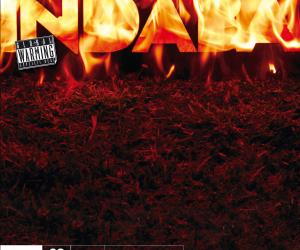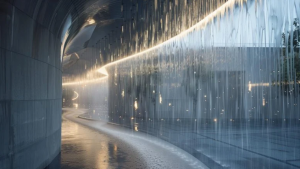First Published in
Yves Béhar has often said that "design brings stories to life". The playful merging of function and emotion has distinguished Béhar's design portfolio as challenging the contemporary status quo with quality and ingenuity – "Design's purpose is not only to show us the future, but to bring us the future," is another of his mantras.
Now with his sophisticated solution to the controversial $100 laptop challenge and his ingenious LEAF Lamp developed for Herman Miller, Béhar's creations are leading a new approach to sustainable informed design for the masses.
What is sustainable design to you?
Design simply considers the betterment, the improvement of things. Today, this betterment includes the notion of health, sustainability and the contribution design can make to many different issues. Every product we work on, whether it is a small venture or a large corporate programme, is studied not just for its innovation and impact, but also for the innovation and impact on new causes.
Is it emotion or wit that fuels sustainable design projects?
I often say that "if design is not ethical, it cannot be beautiful". Design that does not consider the effect of the product at the source or at the consumer interface is hard to justify, especially now that information is available to all. But design must also be useful. Usefulness can be about function; but inspiring, resting the soul or creating a sense of wonder and intelligence around one's life, is a form of usefulness that goes beyond function.
You have said: "My philosophy is to connect emotionally through ideas and content rather than style." Does this have significance for sustainable design, too?
To create a sustainable future, design must be deeply in tune with human needs, deeply connected with emotional needs, deeply self-expressive. Human needs include a healthy environment, which means that the products have to be non-toxic as well as low-energy-consuming.
For example, for Herman Miller, we have recently developed a light that consumes 40% less energy than a compact fluorescent lightbulb. In the case of the LEAF light, the attributes of the product go beyond a singular reason for being, and also provide expressiveness and emotional functionalities such as the ability to switch from an efficient colder light to a warmer mood glow.
As the consummate design storyteller, what is the LEAF story?
It is rare to be able to design both the light source and the light. I wanted LEAF to be both futuristic and familiar, like a blade of grass that lights up at night. At the same time, a new technology demands a new expression and function – the ability to change the light from cold to warm, focusing on the experience of the light. In a way, the simplicity of the form does enhance the experience: The emotion of the light touches you, while one can actually touch the product.
LEAF is about giving a full spectrum of choices to express light's magical and sensory variations. The human senses are engaged through a touch-sensitive interface allowing infinite choices of the light effect: from a cool colour spectrum for an efficient work light to a warm colour for a reflective mood, as well as the continuous adjustment from bright to dark. This poetic interaction follows a principle of "technology with humanity" and is achieved through the use of compact LEDs rather than halogen or fluorescent bulbs.
What were the challenges that you faced in the development of LEAF? What are its sustainability features?
Unlike other LEDs that burn hot and require complicated cooling systems, LEAF stays cool to the touch through the use of a patented heat distribution system that we developed with an engineering group, achieved through an engineered heat sink and the stamp-formed, sculptural aluminium blade that allows heat to be dispersed and released without the use of a cooling fan. This literally allows you to grab the light without any worry of burning your hand.
Environmentally speaking, LEAF's sculptural form was created to minimise material use and mechanical complexities while maximising light options. Its LEDs consume between eight and nine watts of power, carry a 60 000-hour lifespan at full power (about seven years in continuous use), and cut energy use by 40% when compared with standard CFLs.
The steel components of LEAF contain approximately 25% recycled content and are 100% recyclable as a technical nutrient. All die-cast aluminium components are made from 100% recycled material. Aluminium components can be segregated and returned to the recycling stream as a technical nutrient. Plastic components are identified with an ASTM recycling code whenever possible, to aid in returning these materials to the recycling stream. LEAF's packaging materials include corrugated cardboard and a polyethylene plastic bag to protect it from soiling or dust. Each of these materials is part of a closed-loop recycling system.
You have also redesigned a Birkenstock shoe, ensuring that the entire manufacturing process complies with the company's ecological philosophy. Can you take us through the challenges and process of this?
With the Footprints collection, the story developed around the elements that make the product unique and interesting. We felt it was important that the customer be aware of how much effort Birkenstock puts into the conceptualisation and design of their shoes. We also wanted to convey all Birkenstock's traditional values of comfort, craftsmanship and green design, as well as appeal to the taste of the intended customer – the urbanite.
The product was designed from the inside out. The "inside" design started from the redesign of Birkenstock's trademark recycled cork and natural latex insole, then reshaping the fit and, finally, adding biodegradable gels. It continued on the "outside" with a lighter, elegant, more modern aesthetic introducing streamlined details and vegetable-died leathers.
Also, the Scoot hydrogen-powered transport solution addresses sustainable living. Can you tell us about this project?
Scoot was a concept piece designed with Johan Liden to address the need for urbanites to get around town without breaking a sweat – or the environment. Scoot's hydrogen fuel cell motor, a form of energy emergent in northern Europe, propels the user along city streets without harming the environment. The hydrogen fuel cell ensures that the Scoot does not add to city smog.
The Scoot folds into a compact and portable object in seconds for easy carrying or packing on buses and subways. Its folding mechanism – collapsible handle bar that turns into the product's carrying handle and fenders that cover the wheels when the Scoot is folded – propose a total solution to make the Scoot a real commuter product.
The Scoot was designed as an elegant product – in contrast to the youth-market's push scooters, the aesthetics of the Scoot suit a professional user. The design is an expression of both efficiency and modernist simplicity, bringing product design qualities to a new product category that resides at the intersection of the car, train or subway and one's destination.
The One Laptop Per Child (OLPC) project is not directly an environmentally conscious design, more addressing humanitarian elements. Nonetheless, the design has taken the resource challenges of its target market into account. Can you explain how this became integrated into the design? Do you think this may influence other technology products in the future?
When people ask if design isn't a bit of luxury for a product destined for the developing world, I explain that, typically, technology products for the developing world are hand-me-down versions of their Western equivalents – lesser technologies of lesser quality. Additionally, those products are not designed with their specific users or surrounding conditions in mind. Low-cost products are literally "cheap" (low-tech and low quality). This is a paradigm the team at OLPC and MIT wanted to change, by instead creating a high-touch and high-tech product and experience.
Upon reviewing a prototype of the OLPC, Bono spoke of the very real meaning OLPC will have for the kids – DIGNITY and pride to now possess their own education, communication and entertainment tool. What is exceptional in this project is a combination of a radical paradigm shift in an industry and business plan, combined with design to match.
You have mastered a wide array of disciplines, showing off an even wider range of styles. Are we to see more sustainability in your future projects? What does the future hold for you?
What is exceptional in design is the same that is exceptional in life: The things that move us. Usefulness can be about function, but usefulness goes beyond function. I see a bigger role for design in the future, and the opportunity for designers to be true participants in both for-profit businesses and non-profit causes. Humanistic design must tap into the "giving" element of our profession. It must be deeply in tune with the need to create a sustainable future, and deeply connected with emotional needs, deeply self-expressive.
















